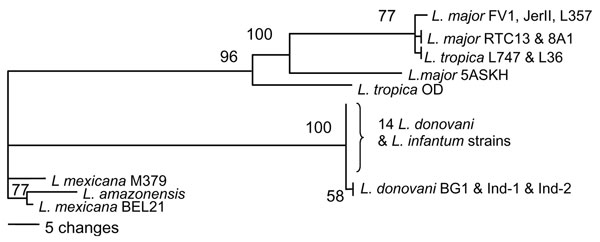Volume 13, Number 3—March 2007
Dispatch
Leishmania donovani and Cutaneous Leishmaniasis, Sri Lanka
Figure 1

Figure 1. Classification of Leishmania species according to the partial DNA sequence of the 6-phosphogluconate dehydrogenase gene constructed with PHYLIP (http://evolution.genetics.washington.edu/phylip.html) using parsimony. Numbers at branch points are bootstrap values compiled by using 100 replicates. Isolates examined and the accession numbers of their 6PGDH sequences in the GenBank/EMBL/DDBJ database are as follows: 11 Sri Lanka isolates, L59, L60, L75, L78, L80, L284, L304, L355, L330, L301, L348 (AJ888888-AJ888898); 2 India isolates, Ind-1, Ind-2 from splenic aspirates of visceral leishmaniasis patients in Muzafapur, Bihar (MHOM/IN/2004/Ind-1 and MHOM/IN/2004/Ind-2, AJ888900, AJ888901); 3 previously identified L. donovani isolates BG1 (MHOM/BD/1997/BG1, AJ888899), LEM719 (IMAR/KE/1962/LRC-L57; LEM719, AJ888902), LV9 (MHOM/ET/1967/HU3;LV9, AY168567); and L. infantum JPC (MCAN/ES/1998/LEM935;JPC;M5, GeneDB LinJ35.2940). Also analyzed were sequences from the following isolates: L. tropica (AY045763, AY168568), L. major (FV1, AF242436; 8A1, AF242436; RTC13, AY706106; JerII, AY706105; 5ASKH, AY706107), L. mexicana (M379, AY217723; BEL21, AY386372), and L. amazonensis (PH8, AY168562).